10 Tips for beginner climbers
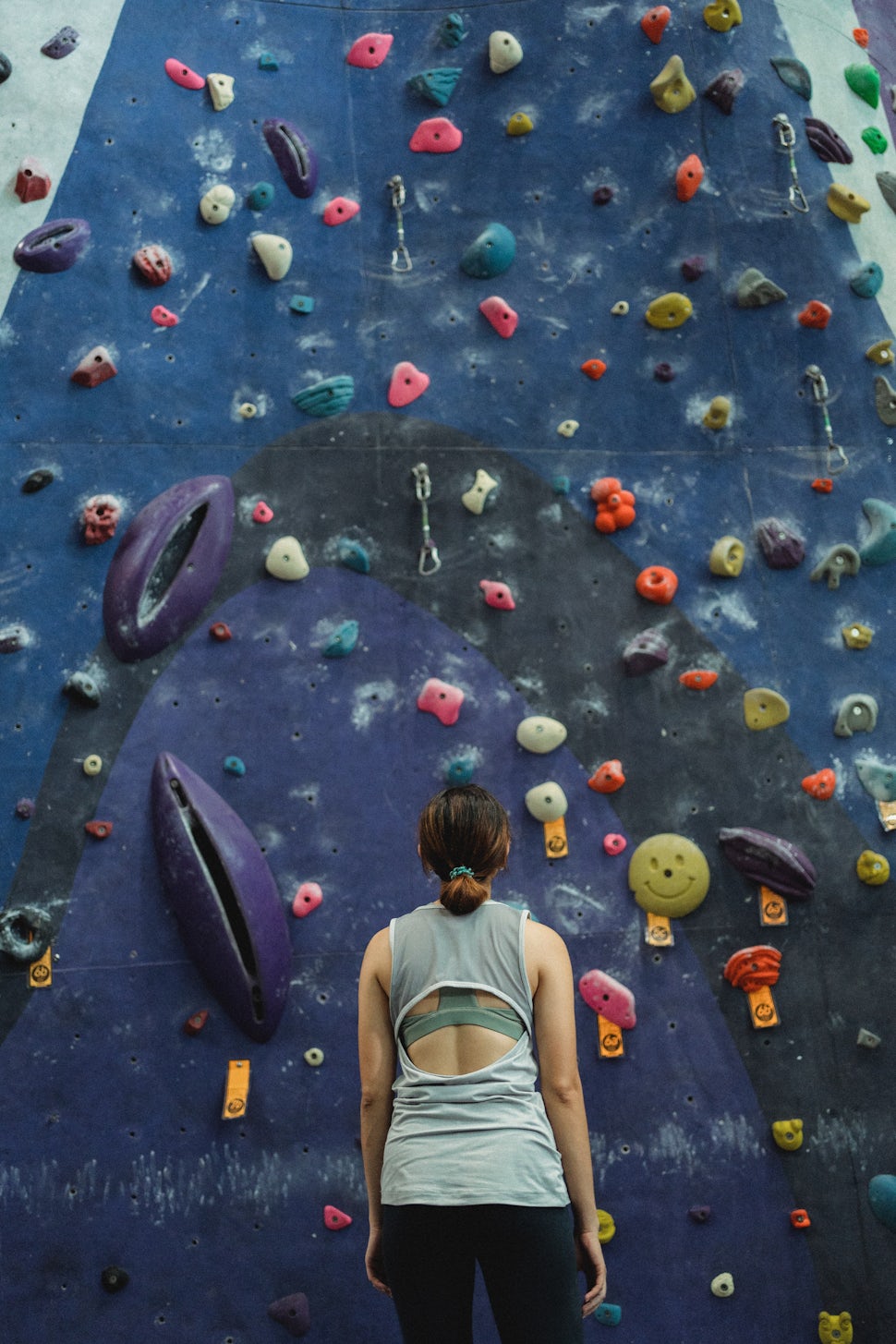
If you clicked on this story, you likely have an interest (maybe even just the tiniest inkling) to give climbing a go. Congratulations! You’re already on the right path because the best thing you can do is to get your feet wet and start learning something new. I’m a beginner climber with lots to learn, so I’m right there with you on this journey.
I am a young adult with absolutely no climbing background (minus the few birthday parties I attended in elementary school at a climbing gym). Though there is some beautiful mountainous terrain in New York, my home state, I never had real exposure to the sport. Climbing first piqued my interest as an adult. In complete honesty, it probably all began after watching Alex Honnold in the iconic Free Solo documentary (if you haven’t watched it, you need to check it out!). Fast forward a little, and I’m backpacking with a friend through backcountry terrain in Wyoming’s breathtaking Wind River Range. Along our route, we met a guy who used to be a pretty intense climber. The way he spoke about his experiences in the mountains and the community of people he met through the sport captivated me even more. I knew I had to get to a climbing gym.
If you’re an adult and think it’s “too late” to pick up a new sport or hobby, change that mindset! It’s never too late to start, or at least try something that speaks to you. You have no idea where it could lead. And, if you don’t like it or it’s not for you, at least you can say you tried!
With that said, it didn’t mean I wasn’t nervous getting started. Read on for some advice if you’ve wanted to try climbing, are curious about it, or want to hear how a complete novice tried something new and really enjoyed it!
1. Phone a friend
Trying something new can be daunting. Doing it by yourself is another added level of scary. Relieve some of the hesitation by making a fun friend date out of it! If you’re interested in climbing, you may have a friend who would also like to try it out. If no one comes to mind, ask around, and you might be surprised how many people out there are itching to try climbing or even have experience and are willing to help show you the ropes (hardy har). Not to mention, your friends may have other friends! That’s how I found my climbing partner– a friend of a friend!
2. Sign up for an intro class
Having someone to guide you through the process is much less intimidating. Research some beginner or intro classes to learn the basics and terms and meet new people. If you work a full day, look specifically for night or weekend classes. My new friend and I signed up for an intro to climbing class, which made taking that first step easier. I was comforted that everyone in our small class had little-to-no experience. It reminded me that you can find people like you who are also nervous and unsure, but excited to learn.
3. Know your options
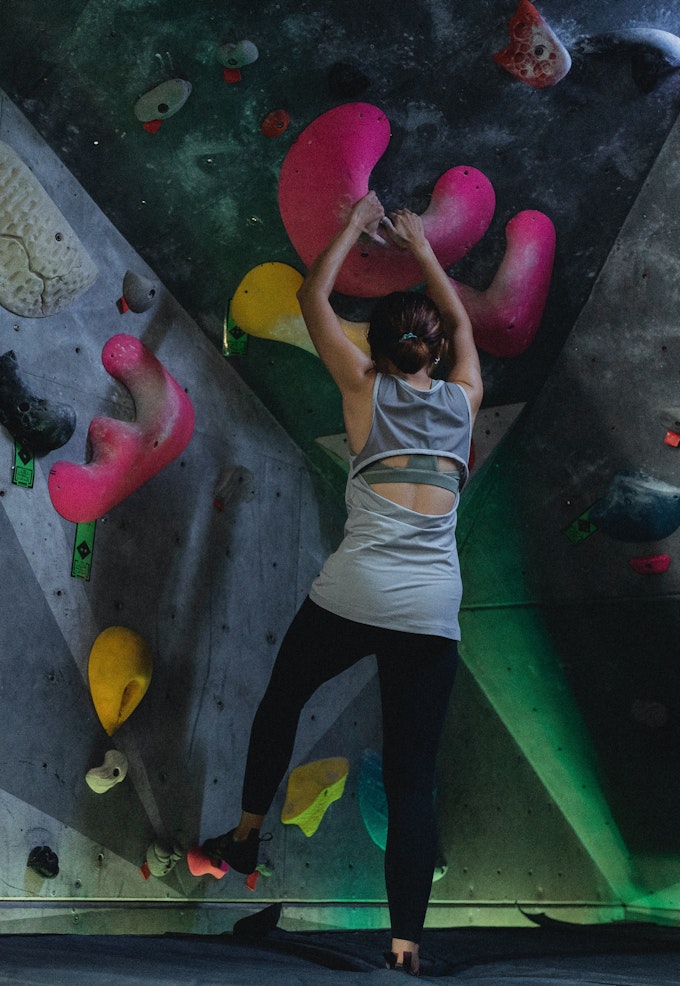
Upon entering the foreign world of climbing, I didn’t clearly understand the different types of climbing. There’s free climbing, lead climbing, top roping, bouldering, aid climbing, and so on. Since there are many types/styles, I encourage you to look into each and see which speaks to you. I wanted to climb with a partner, making top rope climbing a great option.
When top roping, climbers are supported by a rope that runs up and down a rock face, looped through an anchor at the top of the route. A person called a belayer controls the rope, standing beneath the climber on the ground to tighten slack and catch the climber if they fall.
I’ve also given bouldering a go a few times now. Bouldering is a type of free climbing that doesn’t involve ropes or harnesses. Climbers who boulder ascend smaller rock or artificial rock formations. This is a nice option if you want to start getting comfortable with climbing without needing a partner.
4. Get used to falling
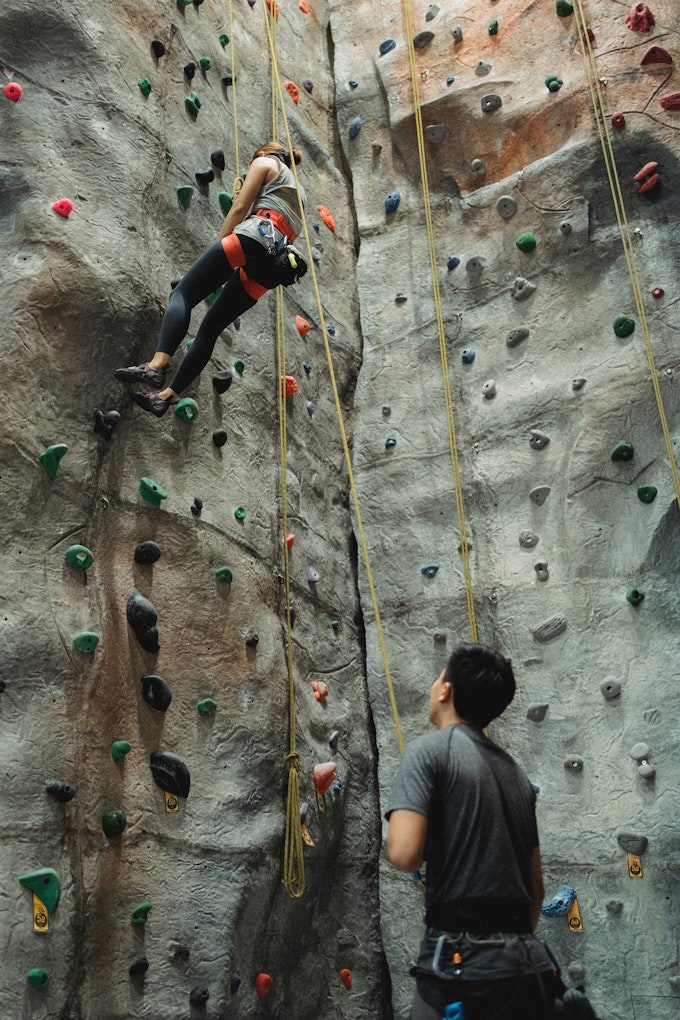
This may be one of the most important tips to learn early on - Whether bouldering or top rope climbing, you’ll need to let go at some point on purpose or if you happen to slip or get tired. Get your body and mind comfortable with the feel of dropping down safely. Practice it a few times.
The first couple of times I went top roping with my climbing partner, the thought of letting go in the middle of a route filled me with fear. After doing it once (my arms fatigued, and I needed to let go), I realized that your climbing partner is belay-certified for this very reason - to catch you and make sure you descend safely. It’s a strange sensation to let go of the wall when you’re so high up, but know that you are harnessed, and your partner is watching closely. It’s okay to let go!
Use belaying commands to communicate with your partner when you are ready to start climbing, when you need them to tighten the slack on the rope, and when you’re ready to come down.
5. You need to learn the ropes (quite literally) first!
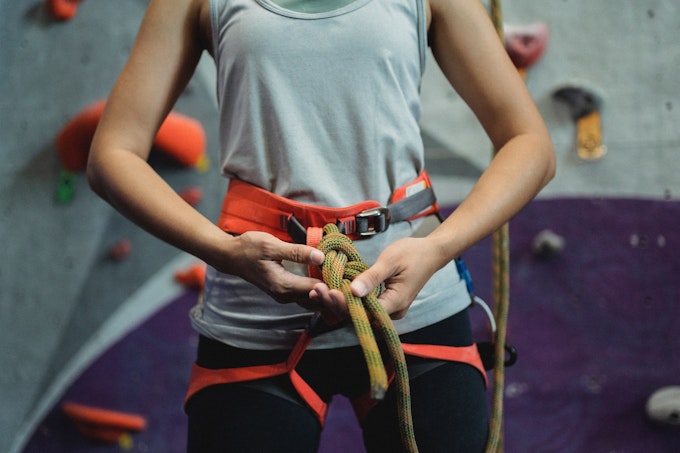
When I envisioned myself climbing for the first time, my mind immediately painted images of me scaling a wall and coolly repelling down. I didn’t realize the primary focus of my intro class would be tying knots called the double figure eight and the fisherman’s knot. Tie… untie… tie… untie… and repeat. Learning how to tie knots is essential because they keep you secure when ascending and descending.
It’s easy to get really excited and want to start climbing right away (that was me), but focus on getting the knots right first to ensure the safest climbing! Note: Most gyms will require you to take a belay certification test before you’re allowed to top-rope on your own, so you’ll need to pay attention and practice!
6. You don’t need to be the face of fitness
Climbing requires strength. There’s no other way to put this, but hoisting yourself up a wall is challenging! Watching videos of ripped, experienced climbers can make it look easy! But don't let that deter you. A lot of people think that to be a climber, or any other type of athlete for that matter, you need to look or be a certain way first. How do you think elite athletes got to where they are now? They had to take their first step and naturally grew stronger along the way.
You don’t need to be in the best shape to start climbing. It helps to be fit, but you’ll gain strength and endurance once you start climbing. You’ll discover new muscles you didn’t know existed. Don’t let your current fitness status stop you from starting.
From the several times I’ve been to the climbing gym, I’ve seen people of all age groups, from tiny tots to older individuals. Don’t concern yourself too much with your age or physical health. The first few times you climb, your muscles will likely burn… but hopefully, you're having fun learning along the way.
7. Decide on a gym
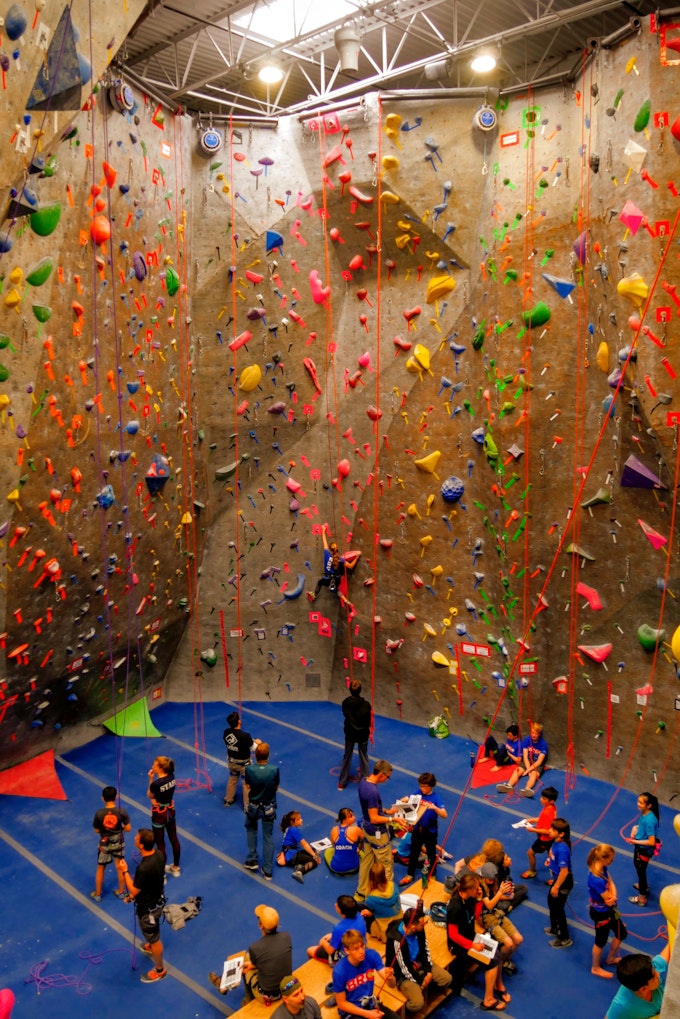
If you’re dreaming of one day getting outside and climbing natural rock… me too! Starting at a gym is a great way to get comfortable with heights and climbing technique before taking it outside where you’ll be exposed to the elements.
So, how do you know where to go? I started by looking up climbing gyms near me on the internet. Luckily, I had one 15 minutes from home. Convenience was a big factor in how I selected my current gym. But I was also pleased to see that it offered beginner and more advanced classes. Knowing that there would be other beginners and instructors available to help out solidified that this gym was a good fit for me.
Location is important, but so is looking for ones that offer beginner classes and instruction. Inquire whether the gym has bouldering or auto belay routes (big wall climbing with an automatic belay machine - no need for a partner). Also, look into what difficulty level problems or climbing sets are available. Some gyms have more beginner-focused walls, while others cater to advanced climbers.
8. There’s a grading system (but don’t worry… not on your performance)
There are grading systems that indicate the physical difficulty level of a climb. Since I’ve been more into top roping, I’ll briefly explain this type of grading system first. There are two types of grading systems for top-rope climbing: YDS and French (depends on your geographic location). YDS stands for the Yosemite Decimal System used for climbing, hiking, and scrambling. This is the system used in the U.S. It will look something like this:
5.11a
The YDS grading system has three main parts. First, they will all start with the number 5 (indicating that the route is a rock wall that requires a rope or other gear). This number is followed by a decimal point and another number. The number that follows “5” ranges from 2-15. This number describes the difficulty of the route based on elements like holds and the moves involved (the higher the number, the greater the difficulty). Third, there’s sometimes but not always, a letter (a, b, c, or d) that tops it all off. The letters describe the difficulty of the climb in even further depth with “a” being easiest and “d” as the most difficult. For more experienced climbers, it helps indicate the feel of the route with greater specificity. Truthfully, when just starting out, I don’t think you need to worry about the letters.
The French scale is used in mostly all other parts of the world and can look like this:
7a+
The first number ranges from 1-9 to describe the difficulty of the climb. The letter (a, b, or c) further defines the difficulty level. And finally, the + sign gives an even more in-depth degree of difficulty specificity.
Bouldering uses a V-scale grading system that looks like this:
V1
The bouldering routes or “problems” (another way climbers refer to routes) start with a “V” followed by a number from 0-17 (0 = easiest, 17 = extremely challenging).
Climbing is a highly subjective and individual sport. There is no way to have a completely objective grading system to determine what is least to most challenging. We can only strive to have an idea of how difficult a climb is. Don’t be discouraged if one day you’re nailing 5.7s and the next you struggle with 5.4s. Each climb is different. You might surprise yourself by nailing a route more difficult than you thought you could complete.
9. Strive for technique
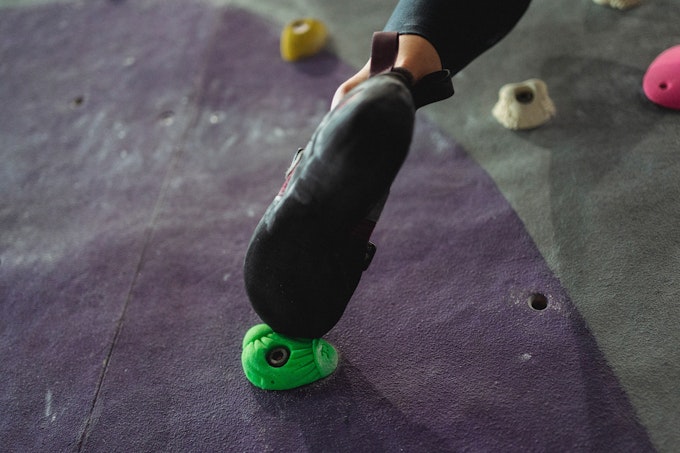
You might find your inner voice telling you you're not strong enough yet, you're not tall enough for this, or you're not flexible.
Stop this thinking right now!
While you can work on flexibility and muscle power, you will have little control over your height and wingspan. Yes, many elite climbers are strong and have great arm reach. But there are also fantastic climbers who are on the shorter side and may not be rippling with defined muscles. Instead, they might have amazing technique! Watch some climbing videos to get a sense of what good technique looks like. Then, head to the gym to try them out.
10. The key component: have fun!
It sounds cliche, but sometimes we need to remember to just have fun. While you’ll likely feel compelled to look around at the gym to see what others are doing or feel frustrated when something isn’t clicking, don’t forget to take a breath and remember why you started this journey.
For me, watching documentaries and hearing stories of people challenging themselves in incredible ways made me excited to try climbing. There’s a distinct spark when you see people doing what they love, even when that thing is challenging or scary. I wanted to replicate this feeling for myself. If I catch myself doubting the process, I remember not to take it all too seriously and enjoy each opportunity I get to climb and feel present with each move.
You can do it! I hope to see you out there!
Cover photo: Allan Mas
We want to acknowledge and thank the past, present, and future generations of all Native Nations and Indigenous Peoples whose ancestral lands we travel, explore, and play on. Always practice Leave No Trace ethics on your adventures and follow local regulations. Please explore responsibly!
Do you love the outdoors?
Yep, us too. That's why we send you the best local adventures, stories, and expert advice, right to your inbox.








